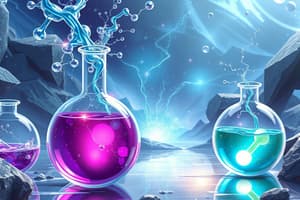Podcast
Questions and Answers
What is the primary use of a refractometer?
What is the primary use of a refractometer?
- To measure electrical resistance
- To measure mass
- To measure refractive index (correct)
- To measure boiling point
Which of the following is NOT categorized as an extensive property?
Which of the following is NOT categorized as an extensive property?
- Volume
- Mass
- Enthalpy
- Density (correct)
What defines a colligative property?
What defines a colligative property?
- It defines the solute-solvent interaction
- It depends on temperature changes
- It depends on the type of substance present
- It depends on the number of components in the system (correct)
Which of the following is an example of a colligative property?
Which of the following is an example of a colligative property?
What is the particle size range for colloidal dispersions?
What is the particle size range for colloidal dispersions?
Which of the following is considered an intensive property?
Which of the following is considered an intensive property?
How are extensive properties differentiated from intensive properties?
How are extensive properties differentiated from intensive properties?
Which of the following types of dispersion has the largest particle size?
Which of the following types of dispersion has the largest particle size?
What defines a solution in terms of its composition?
What defines a solution in terms of its composition?
Which of the following is NOT a type of concentration expression discussed?
Which of the following is NOT a type of concentration expression discussed?
What is the correct term for the combined properties of individual components in a system?
What is the correct term for the combined properties of individual components in a system?
What characterizes a constitutive property in a system?
What characterizes a constitutive property in a system?
Which of the following is an example of a one-phase system?
Which of the following is an example of a one-phase system?
How is molecular weight computed for sodium chloride?
How is molecular weight computed for sodium chloride?
What property is measured using a polarimeter?
What property is measured using a polarimeter?
Which term describes two or more phases in a system?
Which term describes two or more phases in a system?
What characterizes a saturated solution?
What characterizes a saturated solution?
In the context of solutions, what is a solvent?
In the context of solutions, what is a solvent?
Which solution type contains both ions and molecules separated in a solution?
Which solution type contains both ions and molecules separated in a solution?
Which of the following correctly defines a non-electrolyte?
Which of the following correctly defines a non-electrolyte?
What occurs in a supersaturated solution?
What occurs in a supersaturated solution?
Which of the following components is likely considered a solute in the mixture of water and coffee?
Which of the following components is likely considered a solute in the mixture of water and coffee?
Which characteristic of ionic compounds contributes to their solubility in water?
Which characteristic of ionic compounds contributes to their solubility in water?
What is the primary reason that potassium permanganate dissolves in water?
What is the primary reason that potassium permanganate dissolves in water?
What is the formula for calculating molarity?
What is the formula for calculating molarity?
How is the number of moles of a solute calculated from its weight and molecular weight?
How is the number of moles of a solute calculated from its weight and molecular weight?
If you have 5 grams of nickel(II) chloride hexahydrate, what is the molecular weight used for calculating moles?
If you have 5 grams of nickel(II) chloride hexahydrate, what is the molecular weight used for calculating moles?
What is the molarity of a solution made by dissolving 5 grams of nickel(II) chloride hexahydrate in enough water to make 250 mL?
What is the molarity of a solution made by dissolving 5 grams of nickel(II) chloride hexahydrate in enough water to make 250 mL?
What unit is used for expressing molarity?
What unit is used for expressing molarity?
What does normality measure in a solution?
What does normality measure in a solution?
What is the mass required to make a 0.05 molar solution in 250 mL of oxalic acid (H2C2O4)?
What is the mass required to make a 0.05 molar solution in 250 mL of oxalic acid (H2C2O4)?
How is molality defined?
How is molality defined?
What is the weight in grams per liter for a 1% weight by volume solution?
What is the weight in grams per liter for a 1% weight by volume solution?
How is osmolarity calculated for a solution containing aluminum sulfate?
How is osmolarity calculated for a solution containing aluminum sulfate?
What is the molecular weight of calcium chloride?
What is the molecular weight of calcium chloride?
What is the correct calculation for the osmolarity of a 100 grams per liter calcium chloride solution?
What is the correct calculation for the osmolarity of a 100 grams per liter calcium chloride solution?
What is the mole fraction of sodium chloride in a solution with 1 mole of NaCl and 100 grams of water?
What is the mole fraction of sodium chloride in a solution with 1 mole of NaCl and 100 grams of water?
To find the mole fraction of water in the same solution, which calculation is used?
To find the mole fraction of water in the same solution, which calculation is used?
How many milliosmoles per liter does a complete ionizing solution of aluminum sulfate yield?
How many milliosmoles per liter does a complete ionizing solution of aluminum sulfate yield?
Which formula correctly represents the calculation of the mole fraction of sodium chloride?
Which formula correctly represents the calculation of the mole fraction of sodium chloride?
Flashcards are hidden until you start studying
Study Notes
Solutions and Concentrations
- Definition of Solution: A homogeneous mixture of two or more substances, comprising a solute and a solvent.
- Learning Objectives: Students should demonstrate knowledge of solution concentrations and solve related problems.
Types of Systems
- System: A specified quantity of material or a bounded space.
- One-Phase System: True solutions, characterized by molecular dispersion.
- Two or More Phase System: Includes coarse and colloidal dispersions.
Physical Properties of Systems
- Additive Property: Depends on the sum of individual properties (e.g., molecular weight).
- Constitutive Property: Depends on the type/arrangement of components (e.g., optical rotation measured by polarimeter).
- Colligative Property: Depends on the number of components; includes vapor pressure lowering, boiling point elevation, freezing point depression, and osmotic pressure lowering.
Types of Properties
- Extensive Properties: Depend on size/amount in the system (e.g., mass, volume).
- Intensive Properties: Do not depend on size/amount (e.g., density, temperature).
Dispersion
- Definition: Consists of at least two phases with one or more dispersed internal phases in a continuous external phase.
- Types of Dispersions:
- Molecular Dispersion (True Solution): Particle size <1 nm.
- Colloidal Dispersion: Particle size from 1 nm to 0.5 µm.
- Coarse Dispersion: Particle size >0.5 µm.
Definitions of Solutions
- Solution: A homogeneous mixture of solute and solvent.
- Saturated Solution: Contains maximum solute quantity at a given temperature.
- Unsaturated Solution: More solvent than solute.
- Supersaturated Solution: More solute than can normally dissolve.
Classification of Solutes
- Nonelectrolytes: Substances that do not ionize in water.
- Electrolytes: Substances that do ionize in water, often ionic compounds.
Concentration Expressions
- Molarity (M): Moles of solute per liter of solution.
- Molality (m): Moles of solute per kilogram of solvent.
- Normality (N): Equivalent weight of solute per liter of solution.
Example Calculations
- Molarity Example: If 5 grams of nickel(II) chloride hexahydrate is dissolved in enough water to make 250 mL of solution, it is calculated as 0.08 M.
- Osmolarity Calculation: For aluminum sulfate in solution, ionization leads to calculations of milliosmoles based on molecular weight and number of ions produced.
Mole Fraction
- Mole Fraction Calculation: Mole fraction of a solute is calculated using the formula:
- Mole fraction = moles of solute / (moles of solute + moles of solvent).
- Example Calculation: For 1 mole of sodium chloride in 100 grams of water, calculate the mole fraction of sodium chloride.
Assignments and Practice Problems
- Engage with practice problems to solidify understanding of molarity, molality, normality, and mole fractions.
- Familiarize with calculations of osmolarity based on concentration and complete ionization of substances.
Studying That Suits You
Use AI to generate personalized quizzes and flashcards to suit your learning preferences.




